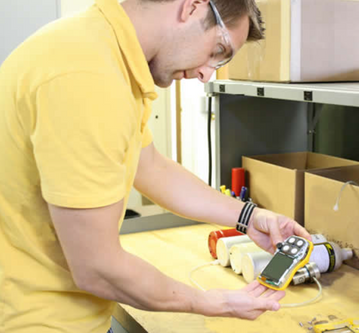How-to: BW Honeywell Gas Detector Calibration
Calibration is very important for a gas monitor. It reestablishes a base line accuracy for the sensors, both electro-chemical and LEL catalytic bead. In order to perform as they were designed, gas monitors need to periodically be readjusted in the same way a guitar string needs tuning. Calibration of your gas monitors isn't difficult or time consuming (unless you have several hundred monitors, in which case it can be very tedious) and it's essential for accurate measurements over time.
Here we'll discuss the process of calibrating one monitor. For this discussion we'll talk about the BW MicroClip XT, though this will also pertain to most of the MicroClip line of monitors including the Quattro and the Max XT II. BW recommends calibration for these devices take place at least every 180 days.
Step 1 Organize. In a clean air environment, get your calibration gas, regulator, tubing, and calibration cap all hooked up and ready to turn on. While the gas and regulator must be purchased separately, the tubing and calibration cap will have been included with the monitor when purchased.
Step 2 With the monitor in regular operating mode, hold down the off button. The unit will display "OFF" and go into a blinking, alarming countdown. Continue holding down the button once the monitor has gone blank. The monitor will then begin a blinking and alarming calibration countdown with "CAL" displayed on the screen.
Once the "CAL" countdown has finished, you can remove your finger from the off button. The unit will now begin to auto-zero.
Step 3 Once the sensors have auto-zeroed, the monitor will prompt you to apply the calibration gas. Attach the calibration cap (this is the small, plastic test cap cover that clips to the front of the monitor and directs the calibration gas to the sensors). Next open the regulator on the top of the calibration gas all the way.
Step 4 The monitor will begin calibration without further actions required. Continue to monitor your screen and be ready to remove the gas when prompted.
Step 5 Follow any prompts on the screen. If the monitor is functioning properly, it will conclude the calibration, and be ready to turn off and return to regular service. If any of the sensors are damaged, or the monitor is not responding properly, further action will need to be taken before it can go back into the field.
If you have further questions, or are not sure how to repair a monitor, please give us a ring at 1-800-829-9580 or contact us online at pksafety.com.
Related Searches
Gas Detector Calibration Service, Bw Calibration Gas, Gas Alert Quattro
Recent Posts
-
Customizing Gas Detectors: Tailoring Solutions to Fit Your Unique Requirements
In today’s diverse industrial landscape, a one-size-fits-all approach to safety simply doesn’t cu …Jul 3rd 2024 -
10 Ways to Prevent Wildfires
You can prevent wildfires by extinguishing flames before you leave the worksite. Avoid practicing …Jul 1st 2024 -
ANSI/ISEA 138 Safety Gloves: Ensuring Hand Protection
The human hand is an anatomical masterpiece and arguably the greatest tool attached to our bodies …Jun 25th 2024





